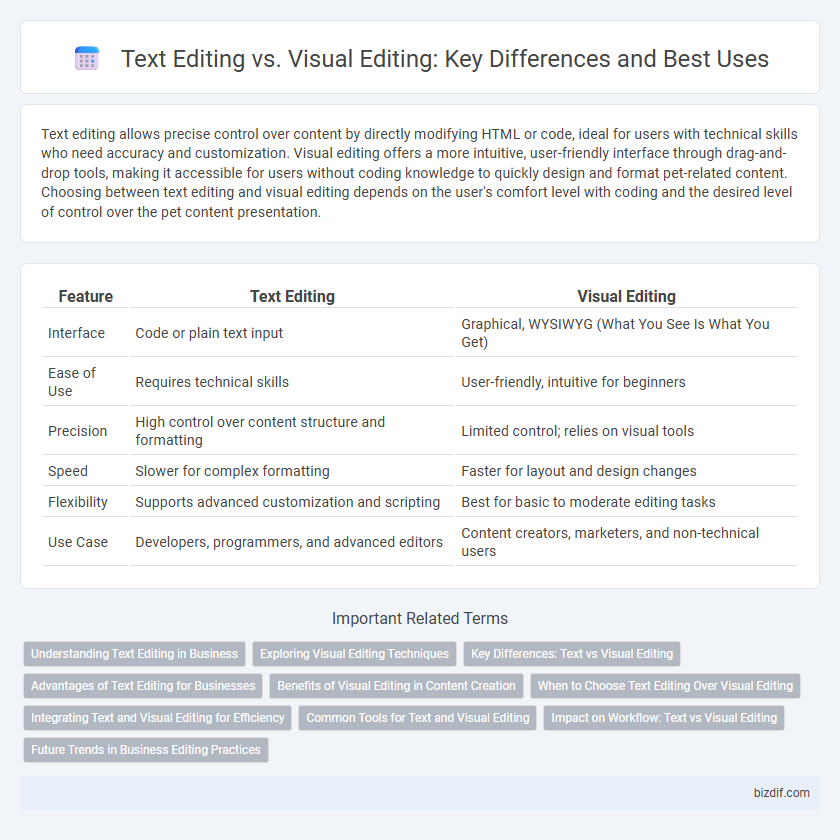Text editing allows precise control over content by directly modifying HTML or code, ideal for users with technical skills who need accuracy and customization. Visual editing offers a more intuitive, user-friendly interface through drag-and-drop tools, making it accessible for users without coding knowledge to quickly design and format pet-related content. Choosing between text editing and visual editing depends on the user's comfort level with coding and the desired level of control over the pet content presentation.
Table of Comparison
| Feature | Text Editing | Visual Editing |
|---|---|---|
| Interface | Code or plain text input | Graphical, WYSIWYG (What You See Is What You Get) |
| Ease of Use | Requires technical skills | User-friendly, intuitive for beginners |
| Precision | High control over content structure and formatting | Limited control; relies on visual tools |
| Speed | Slower for complex formatting | Faster for layout and design changes |
| Flexibility | Supports advanced customization and scripting | Best for basic to moderate editing tasks |
| Use Case | Developers, programmers, and advanced editors | Content creators, marketers, and non-technical users |
Understanding Text Editing in Business
Text editing in business focuses on refining and optimizing written content to enhance clarity, professionalism, and engagement, crucial for reports, proposals, and communications. Unlike visual editing that emphasizes aesthetic layout and design elements, text editing ensures the accuracy, coherence, and tone align with corporate standards and audience expectations. Mastering text editing boosts brand reputation and fosters effective internal and external communication.
Exploring Visual Editing Techniques
Visual editing techniques enhance content creation by enabling real-time layout adjustments and dynamic formatting directly within the interface, boosting precision and efficiency. Tools like drag-and-drop interfaces, inline editing, and live previews facilitate intuitive design modifications without switching between modes. Emphasizing visual editing streamlines workflows, allowing editors to better visualize the final output and reduce the risk of formatting errors.
Key Differences: Text vs Visual Editing
Text editing involves manipulating raw code or markup, allowing precise control over formatting, structure, and underlying elements. Visual editing provides an intuitive, WYSIWYG interface that displays content as it will appear, enabling users to apply styles and layout changes without coding knowledge. Key differences include text editing's reliance on syntax accuracy and visual editing's emphasis on ease of use and real-time visual feedback.
Advantages of Text Editing for Businesses
Text editing offers businesses precise control over content, enabling efficient corrections and refinements without altering underlying code or format. It supports faster workflows by allowing bulk changes and integration with automation tools, reducing manual effort and minimizing errors. This approach enhances content consistency and scalability, essential for brand management and digital marketing strategies.
Benefits of Visual Editing in Content Creation
Visual editing streamlines content creation by providing an intuitive, real-time interface that reflects the final output, reducing errors commonly found in traditional text editing. This approach enhances productivity and creativity by allowing instant adjustments to layout, formatting, and multimedia elements without switching between code and preview modes. By integrating drag-and-drop functionalities and WYSIWYG tools, visual editing empowers content creators to produce polished, visually appealing results more efficiently.
When to Choose Text Editing Over Visual Editing
Text editing is optimal when precise control over HTML, CSS, or code snippets is required, allowing developers to fine-tune attributes and avoid unwanted formatting. It is preferred for handling complex structures, scripting, or troubleshooting issues that visual editors might oversimplify or misinterpret. Professional web designers and developers often choose text editing to maintain clean, semantic markup and ensure compatibility across platforms.
Integrating Text and Visual Editing for Efficiency
Integrating text editing and visual editing streamlines content creation by allowing users to modify textual elements and visual components within a unified interface, reducing the need to switch between tools. This integration enhances workflow efficiency, as real-time updates in both text and visuals ensure accuracy and consistency throughout the editing process. Combining these editing modes supports better alignment of design and content, improving overall quality and reducing revising time.
Common Tools for Text and Visual Editing
Common tools for text editing, such as Microsoft Word and Google Docs, provide features like spell check, grammar correction, and formatting options essential for refining written content. Visual editing tools including Adobe Photoshop and Canva offer capabilities for image manipulation, layout design, and graphic enhancements, catering to visual content creators. Integrated platforms like Adobe InDesign and Figma combine text and visual editing functionalities, allowing seamless collaboration and efficient content creation across different media types.
Impact on Workflow: Text vs Visual Editing
Text editing enhances precision and efficiency by allowing direct manipulation of code or content structure, streamlining complex adjustments in workflows. Visual editing offers intuitive interaction through graphical interfaces, accelerating the design process and reducing errors for non-technical users. Combining both approaches optimizes workflow flexibility, catering to diverse editing needs and improving overall productivity.
Future Trends in Business Editing Practices
Text editing in business increasingly leverages AI-powered tools for precision and efficiency, automating grammar checks and content restructuring. Visual editing is advancing with augmented reality and collaborative platforms, enabling real-time design adjustments and interactive content creation. Future trends emphasize integrated editing suites that blend text and visual elements, enhancing workflow fluidity and accelerating project turnaround times.
Text Editing vs Visual Editing Infographic

 bizdif.com
bizdif.com